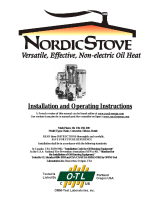
Table of Contents 3
© Travis Industries 12/27/2018 - 1461 Northfield Radiant
Introduction .............................................................. 2
Important Information .............................................. 2
Listing Details ........................................................... 2
IAS (ICBO) Approval ............................................. 2
Features: ............................................................... 6
Installation Options: .............................................. 6
Heating Specifications ............................................. 6
Dimensions & Weight .............................................. 6
Electrical Specifications .......................................... 6
Fuel ............................................................................ 6
Packing List .............................................................. 8
Additional Items Required ....................................... 8
Installation Overview ............................................... 8
Stove Clearances ..................................................... 9
Mobile Home Requirements .................................... 9
Heater Placement Requirements .......................... 10
Floor Protection Requirements ............................. 10
Electrical Requirements ........................................ 10
Gas Line Installation .............................................. 11
Gas Inlet Pressure .............................................. 11
Altitude Considerations ....................................... 1 2
Approved Caps ................................................... 12
Approved Vent .................................................... 13
Vent Installation .................................................. 13
Approved Vent Configurations ............................. 14
Restrictor Position ............................................... 14
Measuring Vent Lengths ..................................... 14
Opening the Diffuser ........................................... 15
Vent Configurations with Vertical Termination ... 16
Vent Configurations with Horizontal Termination17
Vent Termination Requirements (see illustration
below) ...................................................................... 18
Class A Chimney Conversion Kit (top vent
configuration only) ................................................. 19
Interior Masonry Chimney Conversions (top vent
configuration only) ................................................. 20
Steps for Finalizing the Installation ...................... 21
Air Shutter Adjustment ........................................ 2 1
Face and Glass Removal ....................................... 22
Log Installation ....................................................... 24
Rear Log Placement ........................................... 24
Left Log Placement ............................................. 25
Right Log Placement ........................................... 2 5
Left Twig Placement ........................................... 2 6
Right Twig Placement ......................................... 26
Rock Wool Placement ......................................... 27
Ember Placement ............................................... 2 7
Before You Begin ................................................... 28
Location of Controls .............................................. 28
Starting the Pilot .................................................... 29
Starting the Heater for the First Time ................... 30
Turning the Heater On and Off .............................. 30
Adjusting the Flame Height ................................... 30
Adjusting the Blower Speed (Optional) ................ 31
Normal Operating Sounds ..................................... 31
Normal Operating Odors ....................................... 31
Power Outages ....................................................... 31
Maintaining Your Stoves Appearance .................. 32
Cleaning the Glass .................................................. 32
Painted Surfaces ............................................... 32
Yearly Service Procedure ...................................... 3 3
Replacement Parts List ......................................... 35
Wiring Diagram ....................................................... 36
Optional Blower Wiring ....................................... 36
Safety Label ........................................................ 37
CONDITIONS & EXCLUSIONS ............................... 38
IF WARRANTY SERVICE IS NEEDED: .................. 38
LP Conversion Instructions .................................. 39
Install the LP (propane) pilot orifice following the
instructions below. .............................................. 40
Optional Remote Installation................................. 42
Optional Blower Installation .................................. 4 3
Index ........................................................................ 44





















